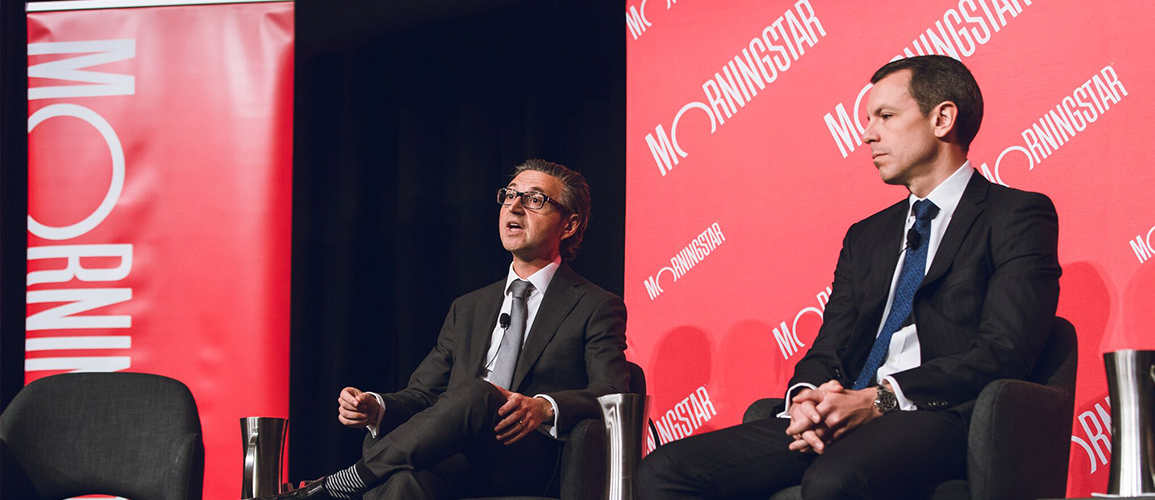In the past decade, one of the fastest-growing sectors in financial markets undoubtedly has been exchange-traded products (ETPs). As at 31 March 2018, 176 ETPs, with a market capitalisation of $36.3 billion, were available on the Australian Securities Exchange (ASX). The sector is accumulating assets at an extraordinary rate. New exchange-traded funds (ETFs) are being launched at an almost overwhelming pace, with varied labels including active; multifactor; fixed income; environmental, social, and governance; and many more.
At the Morningstar Investment Conference on 24 May 2018, Alex Prineas, Morningstar’s associate director of passive strategies, hosted an innovative session —Current Trends in ETFs—that brought together new perspectives and investment views on this rapidly expanding sector of the market. Jonathan Howie, head of ETF product and strategy for iShares/Blackrock, the world’s largest ETF provider, and Alex Vynokur, chief executive officer of BetaShares, one of Australia’s fastest-growing ETF managers, provided insightful industry observations.
What’s Driving the Growth of ETFs?
The initial discussion centred on the buoyant growth of ETFs among investors. Howie outlined that recent data showed the average age of a retail ETF investor fell from 58 to 45 years as the understanding and popularity of the financial product grew, leading to a wider demographic group using ETFs. He also noted that investors traditionally had used ETFs to provide access to a single asset class like domestic or global equities. But now investors have expanded their use of ETFs into building an entire diversified portfolio, for tactical purposes, or as a low-cost component in a core and satellite portfolio. Key benefits of ETFs emphasised by both Howie and Vynokur were low costs, simplicity, transparency, liquidity, and control.
The discussion then ventured onto the issue of whether investors cared what the ETF used as a benchmark or whether price drove demand. IShares Core S&P/ASX 200 ETF (ASX code: IOZ) uses the S&P/ASX 200 Accumulation Index and has a low management fee of 0.15% per year, and its dominant size makes it highly liquid. However, the recently launched BetaShares Australia 200 ETF (A200) uses the lesser-known Solactive Australia 200 Index and has a management fee of 0.07% per year, placing it among the lowest-cost Australian shares ETFs available on the ASX. Vynokur indicated that benchmarks were an important issue for institutional investors but less so for retail investors, who were often focused more heavily on price. Vynokur also discussed how ETFs were used by investors to mainly provide a core allocation, tactical exposure, or low-cost entry to an asset class, and that the meticulous details of specific benchmarks were often a secondary consideration.
Can ETFs Contribute to Market Bubbles and Volatility?
The session also explored whether ETFs may be contributing to market bubbles and volatility. Both Howie and Vynokur were firmly of the view that this was not the case, believing that while a future market downturn was inevitable, it would not be caused by ETFs. Howie believed this was similar to blaming shipping containers for any drop in global trade. Both presenters also noted that the popularity of ETFs has resulted in greater diversification by retail investors across asset classes (from domestic equities to global equities, fixed interest, global property, and global infrastructure).
Numerous active ETPs are being launched each year, giving investors easy access and efficient exposure to often well-regarded, unlisted strategies across asset classes. However, these ETPs typically charge higher management fees than passive ETFs and may have wider bid-ask spreads. Prineas noted that with active ETPs “you are giving up the traditional low-cost characteristic, with the expectation of outperformance by the manager.” Vynokur believes there is a large secular trend towards transparent, low-cost passive, and smart-beta ETFs and away from active investment management. But active is here to stay, so while there will be growth in active ETPs, it will be slower than passive and smart-beta ETFs. Howie pointed out that in Canada, where regulation enforces transparency and clarity, the active ETP market is large and rapidly increasing. He contrasted this with the Australian market, where full transparency is not required by regulators, and suggested that it might be worth exploring the Canadian model. In Australia, investors sought transparency, but active managers preferred to protect their intellectual property and remain reasonably opaque.
The issue of ETFs, corporate governance, and activism was discussed. The massive wave of passive investing in the past decade has resulted in more concentrated voting power in the hands of the major index fund managers. Once again, both Howie and Vynokur indicated that their organisations engage actively with company boards and vote on contentious issues. And it’s clear to see that the attitudes and practices around voting and governance for index fund managers will only become more important as the ETF market continues to grow.
 Morningstar
Morningstar





